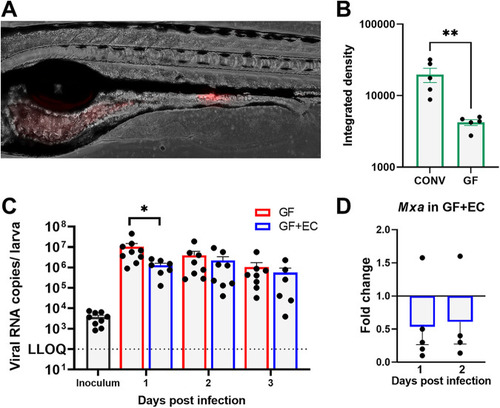FIG 4
- ID
- ZDB-FIG-221226-143
- Publication
- Cuvry et al., 2022 - The Role of Histo-Blood Group Antigens and Microbiota in Human Norovirus Replication in Zebrafish Larvae
- Other Figures
- All Figure Page
- Back to All Figure Page
|
E. cloacae colonization has limited effect on HuNoV replication. (A) Representative image of E. cloacae colonization in 4 dpf larvae. Red fluorescent protein (RFP) signal produced by E. cloacae is overlaid with a brightfield image. (B) Total bacterial colonization in conventionally raised larvae (CONV) and germfree (GF) larvae represented by quantification of RFP signal. Total RFP signal in individual larvae was quantified with ImageJ. (C) Viral RNA copies of HuNoV in GF or GF + E. cloacae-colonized (EC) larvae. The larvae were colonized at 3 dpf and infected with a GII.4 HuNoV-positive stool sample at 4 dpf. The bars represent viral RNA copies/zebrafish larva, quantified by RT-qPCR. The dotted line represents the LLOQ. (D) The effect of HuNoV GII.4 replication on the expression of mxa in GF and GF+EC larvae, determined by RT-qPCR. The bars represent the relative expression of mxa in HuNoV-infected GF+EC larvae versus infected GF larvae compared to 0 dpi and normalized to the housekeeping genes (n = 5). The mean values ± SEM are presented. Mann-Whitney tests were performed to detect significant differences. *, P ≤ 0.05; **, P ≤ 0.01. |

